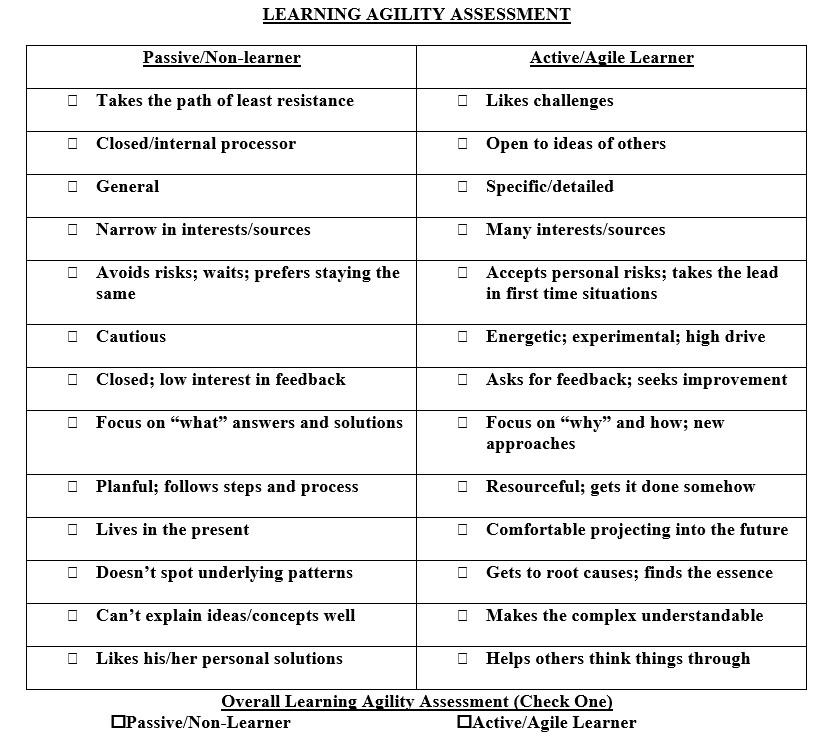By Dr. Carl Fowles, SPHR, PCC
In our current VUCA (volatile, uncertain, complex, ambiguous) world many organizations struggle to find the right combination of capabilities to manage change and continue to thrive. The intentional and unintentional disruptions in organizations become, as Peter Vaill introduced, the metaphorical “permanent whitewater.” This metaphor describes the complex, turbulent, changing environment in which leaders are trying to operate, and the difficult conditions under which leaders exercise their will and judgment. Navigating through permanent whitewater requires leaders to be open to change and new thinking, willing to take risks, able to adapt quickly, negotiate ambiguity, and demonstrate resilience in dealing with setbacks. Learning Agility is the key to navigating the “permanent whitewater” of organizational life because it requires leaders to be learners first – i.e. “agile” learners.
Learning Agility is the key because it is the willingness and ability to learn new competencies in order to perform better in first-time, tough, or changing situations. Research shows that Learning Agility (or LQ) is more accurate and predictive of long-term potential and performance than is raw intelligence (IQ). According to research by Robert W. Eichinger and Michael M. Lombardo, ( LQ) is being able and willing to derive meaning from all kinds of experience. It’s figuring out what to do when you don’t know what to do.
“Learning to learn is key to becoming a leader,” wrote Bennis and Thomas in Geeks and Geezers (2002). “The ability to learn is a defining characteristic of being human; the ability to continue learning is an essential skill of leadership. When leaders lose that ability, they inevitably falter. When any of us lose that ability, we no longer grow. Leaders create meaning out of events and relationships that devastate non-leaders…they look at the same events that unstring those less capable…and see something useful. The signature skill of leaders is the ability to process new experiences… and to integrate them into their life.” LQ is soft learning and IQ is hard learning. Learning new ways to think, solve problems, behave, and manage is primarily LQ. Learning new technical skills and acquiring product and industry knowledge is primarily IQ.
Learning agility encompasses five factors:
- Mental agility—embracing complexity, examining problems in unique ways, making fresh connections, and staying inquisitive.
- People agility—being open-minded toward others, enjoying interaction with diverse groups, bringing out the best in others.
- Change agility—willingness to lead transformation efforts, continuously exploring new options.
- Results agility—delivering results in tough situations, responding to challenge, inspiring others to achieve more than they thought possible.
- Self-awareness—being reflective, understanding strengths and weaknesses, seeking feedback and personal insight.
Leaders need to grow, adapt, and evolve in their current jobs and prepare for future roles, or they risk becoming incompetent. This is why Learning Agility is the most important capability to look for in leaders today. And the good news is that Learning Agility: (1) can be assessed by observation, formal assessment, and behavioral interviewing, and (2) can be developed. An “agile” learner can develop Learning Agility by focusing on (1) Motivation – the willingness to be exposed to challenging experiences, (2) Ability – the capability to capitalize on challenging experiences, and (3) Application – the flexibility to apply what is learned to future situations.
Learning Agility assessment example:

A person can learn how to navigate the complexities of actual permanent whitewater by learning what to focus on, and building habits like: (1) riding the craft (adapting and going with the flow), (2) using appropriate hand positions on the paddle at the right times (using the right skills at the right time), (3) using the right positions and strokes of the paddle (synchronizing with others and the environment), and (4) bracing when about to hit hard objects (dealing correctly with opposition and adversity).
Learning Agility is the key to navigating the “permanent whitewater” of organizational life because the complexities and challenges leaders face require leaders to be learners first – i.e. “agile” learners – and do so in a consistent pattern. As Peter Vaill said, “permanent whitewater means permanent life outside one’s comfort zone,” and to always say “I may not know exactly now, but I have the capacity to figure it out. I have Learning Agility.”

